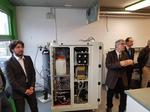Other

“The current record for a bicycle travelling across flat road is 133.78 km/h, set in 2012 by a Dutch team at the World Human Powered Speed Challenge, which takes place every year in the Nevada desert. But this …

“Despite the rise of solid-state drives, magnetic storage devices such as conventional hard drives and magnetic tapes are still very common. But as our data-storage needs are increasing at a rate of almost 15 million gigabytes per day, scientists are …

“Most naturally occurring materials have a disordered atomic structure that interferes with the propagation of both sound and electromagnetic waves. When the waves come into contact with these materials, they bounce around and disperse – and their energy dissipates according to …
“Thanks to an unorthodox approach being proposed by EPFL researchers, patients may soon be able to track their illness simply by drinking a solution containing millions of tiny electronic sensors disguised as bacteria. Imagine being able to track the development …
“In the field of photovoltaic technologies, silicon-based solar cells make up 90% of the market. In terms of cost, stability and efficiency (20-22% for a typical solar cell on the market), they are well ahead of the competition. However, after …

“Infrared spectroscopy is the benchmark method for detecting and analyzing organic compounds. But it requires complicated procedures and large, expensive instruments, making device miniaturization challenging and hindering its use for some industrial and medical applications and for data collection out …

“It’s a whole new way of thinking about sensors. The tiny fibers developed at EPFL are made of elastomer and can incorporate materials like electrodes and nanocomposite polymers. The fibers can detect even the slightest pressure and strain and …

“Brain-computer interfaces (BCIs) are seen as a potential means by which severely physically impaired individuals can regain control of their environment. BCIs use the electrical activity in the brain to control an external device. They have seen growing use in …

“Why do virtual reality headsets make users nauseous? One reason is latency, or the almost imperceptible amount of time it takes for a display image to change in response to a user’s head movement. However, the Joint Photographic Experts …

“Scientists at EPFL and GRT Group have built the world’s first integrated power supply unit that can produce electricity from formic acid, using a fuel cell in an energy-efficient, safe, cost-effective, and sustainable way. When it comes to renewable …
